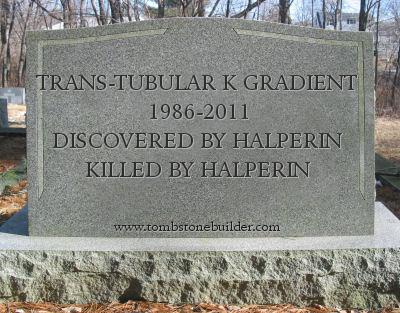TTKG(Transtubular K gradient)は、腎臓における主たるK排泄のセグメントである皮質集合管におけるK分泌の指標であり、臨床において、低K血症、高K血症の鑑別診断に有用とされてきた。
しかし、TTKGをもともと提唱したHalperinは、2011年に出した下記の論文で、内髄質集合管において大量の尿素の再吸収が存在することから、TTKG算出の仮定が崩れたので、もはや、TTKGは使わない方がよいと薦めている。
As a large quantity of urea is reabsorbed daily in the inner medullary collecting duct, the assumption made in the calculation of the transtubular K concentration gradient that there is no appreciable reabsorption of osmoles downstream CCD is not valid.
実際、UpToDateを読むと、
Transtubular potassium gradient — In a later publication, the authors of the original studies found that the assumptions underlying the TTKG were not valid. It was concluded that the TTKG was not a reliable test for the diagnosis of hyperkalemia. We recommend not using the TTKG to evaluate patients with hyperkalemia.(UpToDate, Causes and evaluation of hyperkalemia in adults)
となっており、高K血症の鑑別においてTTKGは使わないようにと明記してある。
低カリウム血症の鑑別においては、そこまで踏み込んで書かれてはいないが、腎臓におけるK喪失の有無は24時間蓄尿または、スポット尿におけるカリウム-クレアチニン比で判断することが薦められている。
Assessment of urinary potassium excretion — The best method for assessing renal potassium excretion is a 24-hour urine collection. However, the potassium concentration or, preferably, potassium-to-creatinine ratio on a spot urine are alternatives.(UpToDate, Evaluation of the patient with hypokalemia)
私が愛読しているPrecious Bodily Fluids http://www.pbfluids.comには、こんな皮肉の写真が載っている。
